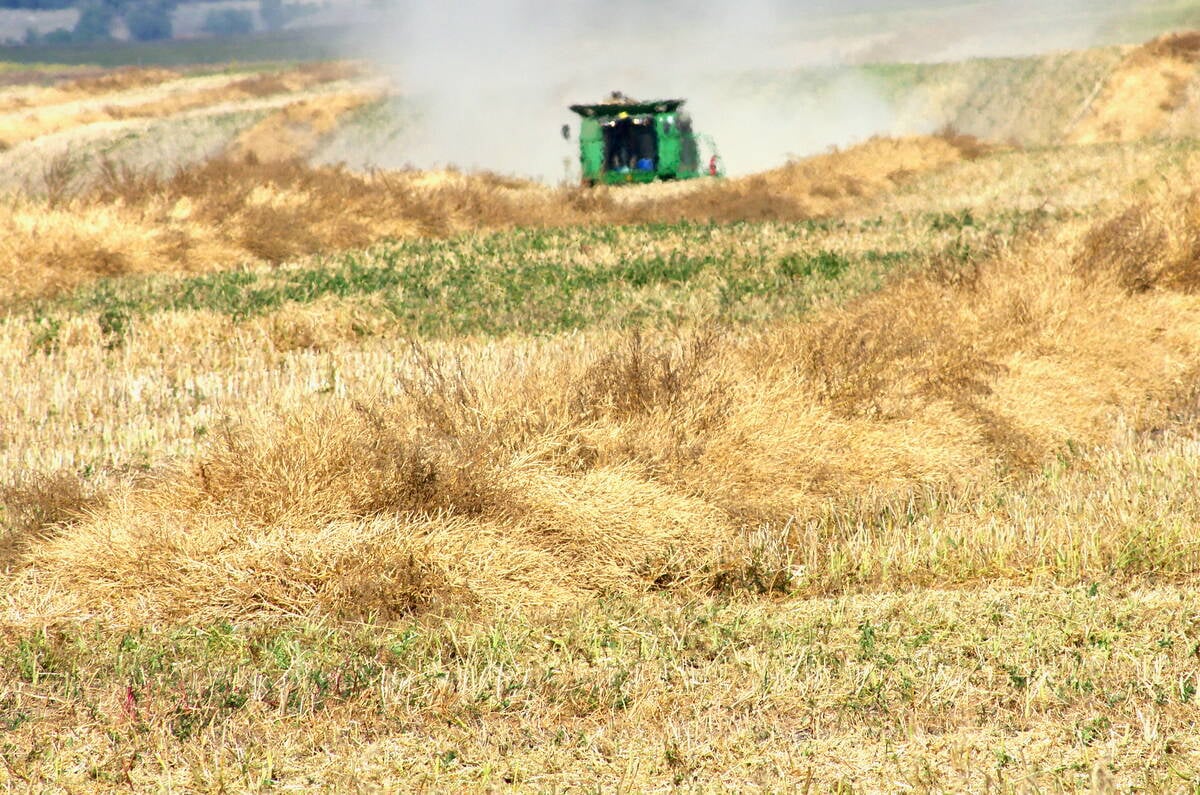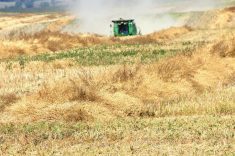Ben Thorlakson once heard that the rules are made by those who show up.
That observation struck a chord with the Alberta feedlot owner, who got involved more than 25 years ago in beef organizations because he wanted to be heard. He presided over them all, learning the ways of human nature and cattle politics. He gained respect and always spoke his mind.
“Unless you are there, then you may as well be talking to yourself,” he said from his office at Thorlakson Feedyards near Airdrie, Alta.
Read Also

Manitoba searches for Plan B on canola oil exports
A new report explores Manitoba’s current canola oil trade and possible alternative markets to the U.S.
“It is your responsibility to protect your interests. If you want to have an effect, you’ve got to get involved.”
It has been an interesting journey for Thorlakson as he navigated through tumultuous changes for the beef industry and Canadian agriculture.
One of Canada’s most recognized cattle producers, Thorlakson grew up on a sheep ranch in Vernon, B.C., and earned a degree in agriculture from the University of British Columbia. He was accepted into a veterinary medicine program but decided to take a year off and join the meat processing company Canada Packers. A couple years later he was working for an American cattle management firm, where he saw big ranches and large scale feedlots in the Midwest. By now it was the late 1960s and there was nothing comparable in Canada.
“I could see this was the wave of the future,” he said.
Thorlakson left the company and told people he was going into the feedlot business, even though he had no money and no practical experience.
With a $30,000 loan from his father, he bought a quarter section of land north of Airdrie in 1970. The property cost $32,000 and included a house, granaries and 7,000 bales of straw. He was in the right place at the right time.
“It was really a case of extraordinary luck. I came into the feedlot business at a time when we had about four or five years of pretty good earnings. Cattle ownership was positive so it was easy to have customers.”
Looking back, he believes only a young person would have taken such a great
leap into a business of thin margins and high risk.
“There is something in the way we are created, and it is part of some great scheme, that you are not burdened with fear when you are young.”
His goal was to have 3,000 head of cattle. The place eventually grew to 8,000 head and his final expansion on this site to 20,000 came in 1990.
He also bought Cattleland Feedyards in Strathmore, Alta., in 1975, which he sold in 2003.
In 1980, Thorlakson added a research component at the Airdrie property. About 70 published studies emerged from the project, some of which he co-authored. Other work involved collaborations with Alberta veterinarian Kee Jim, who studies new product submissions for the Veterinary Drug Directorate.
Most recently, the 120 research pens were converted to handle a 2,000 head bull performance test station, where young bulls are assessed for rate of gain and group feed efficiency for various breed associations.
While he was building his business, Thorlakson joined the Alberta Cattle Feeders Association and became its president from 1980-81.
The next step was a four year stint as a delegate to the Alberta Cattle Commission starting in 1982. He later returned in 1992, was elected to the board of directors and also won a seat with the Canadian Cattlemen’s Association. He was elected chair of the ACC and later became CCA president for two years. His most recent position was chair of the Canada Beef Export Federation for four years. He remains on that board as past chair.
Thorlakson’s involvement with these organizations coincided with tumultuous change in the beef industry, brought on by shifting government policies, American trade protectionism and the discovery of BSE in Canada.
The flow of cattle from east to west was already switching from north to south with the signing of the North American Free Trade Agreement in 1989, he recalls.
This trend was entrenched when the federal government disbanded the Crow transportation benefit in 1995. Rather than move feed grain around the country to collect a subsidy, it stayed in the West and the livestock population soared.
Feedlots expanded and major packers located on the Prairies, turning the region into a beef powerhouse.
In the mid-1990s, Thorlakson helped start the Northwest Pilot Project to bring American feeder cattle into Canada with no restrictive health tests. The program has had ups and downs because the Americans want full access year round while Canadian officials are concerned about bluetongue and anaplasmosis.
He feels regulations under the Canadian Food Inspection Agency and Health Canada have hindered the free flow of livestock north and south.
“There are a lot of good people in CFIA but their report card is on the basis of strictly what diseases we can keep out of Canada and the Canadian health status.”
Thorlakson said his approach to opening trade is based on common sense. Wildlife could easily harbour these diseases and move across borders without ill effects. Nor does he buy the argument that this initiative could hurt trade with other nations.
“The concern is we are compromising our trade with Europe. But who the hell do we sell live cattle to in Europe? Our trade is with the United States.”
A costly trade dispute under Thorlakson’s watch grew out of the industry’s achievements as a major exporter, mainly south of the border.
American producers scrutinized that success with alarm, particularly in the northwestern states where livestock and grain producers watched Canadian trucks make a beeline across the border to their feedlots and packing plants.
That alarm laid the groundwork for a group of beef producers from Montana, who formed an organization in 1998 called the Ranchers-Cattlemen’s Action Legal Fund. The group was convinced Canadian farmers were unfairly subsidized at the expense of American producers, and threatened retaliation.
Trade disputes with the U.S. were not new, but this time Canada was in trouble.
Thorlakson was president of the CCA as the little known R-CALF launched a major anti-dumping and countervail action against Canada that ultimately cost beef producers and taxpayers about $7 million to defend. In the summer of 1999, the U.S. Department of Commerce ruled Canada was subsidizing cattle production and tariffs resulted.
The International Trade Commission ruled in November 1999 that U.S. producers were not injured by Canadian live imports and the tariffs were lifted.
With that ruling people thought
R-CALF was finished, until BSE was discovered in Canada.
That situation reinvigorated the protectionist group, which charged that Canada’s health standards were inadequate. R-CALF won a court decision to keep the border closed, even after a U.S. Department of Agriculture rule outlined new standards for trade. The BSE embargo was a divisive issue on both sides of the border among those wishing to protect domestic markets and those favouring open trade.
“Protectionism is an easy message to sell, particularly in the U.S. It is not really big picture stuff,” Thorlakson said.
It is not common in Canada because so much of the agricultural economy is trade dependent.
“We have to do whatever we can to nourish an environment of freer trade and of course, fair trade.”
In his latest position with CBEF, Thorlakson continues to see the reverberations of BSE and loss of trade to lucrative markets. Closed borders created frustration, yet they brought Canadian producers together.
“One thing about BSE is that it really brought forward a lot of people who are key to the industry and got them involved and engaged in the issues,” he said.
“When things are going well, most people stay home and do their work.”
While trade has returned to near normal levels with the U.S., other markets are closed. He does not know when trade might fully normalize.
“I find it a lot easier to predict a market opening after it happens,” he said.
The federal and provincial governments helped build a strong international marketing program but Japan remains elusive.
“Japan is the absolutely critical one. The other Asian countries view Japan as the leader. They have the wealthiest and strongest economy, they have the veterinary structure, they have the food safety structure.”
Thorlakson and his wife, Betty Ann, recently became a grandparents and he loves to share the successes of their children aged 15-33. The family lost a son two years ago.
His two youngest children are still in high school while his four adult children include a professor, physician, teacher and veterinarian.
At age 61, he continues making plans for the future as a beef ambassador because he is still having fun and learning new things.
“I could do this for a long, long time. I like the mix of people working with us here and the idea of retirement fills me with dread.”















